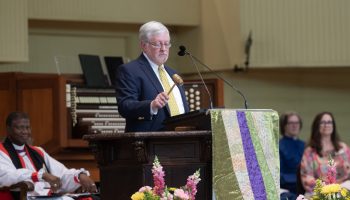
Column by Mary Lee Talbot
“Gardening is a gift I did not receive. Now that I am the caregiver for my mom, our dog Piper, and the house and yard, I am realizing how much work a yard takes,” said Sister Teresa Maya at the 9:15 a.m. Thursday morning worship service in the Amphitheater. Her sermon title was “The Weeds Appeared As Well …,” and the scripture reading was Matthew 13:24–30.
“I hate weeds; they always grow, even in winter,” she continued. “But I wondered why the farmer told his workers to let the weeds and the wheat grow together. Don’t the weeds grow faster? But this is why we need biblical scholars.”
The weeds in the story from Matthew’s gospel are not ordinary weeds. “They are a wheat weed, called tares or darnel tares in English, though I prefer the Spanish word: ‘cizaña.’ It is a type of weed that tends to grow in the Middle East, and you can’t tell the difference until the wheat head appears. And if the tares are ground with the wheat, it can produce a toxic flour,” she told the congregation.
So the first lesson, Sister Teresa said, is that there are different kinds of weeds. The ones in her backyard grow fast, don’t look like the grass and can be pulled out easily. The kinds of weeds Jesus was talking about have a more subtle difference. “We are the servants, and we ask God, ‘Why did you plant weeds? Why didn’t you plant good seed?’ ”
It would be easier, she said, to pull up everything and start over, but with so many challenges in the world, “do we really know the difference? Our confidence has been shaken in these times, and no matter what kinds of weeds they are, we can use weed killer, pull them or find someone to tend to them.”
Because the farmers could not tell the difference between the wheat and the tares, they had to leave all the plants until harvest time. Then at harvest time, there is a sifting, of separating the tares and the wheat.
In Spanish, there is a word for sifting flour in the kitchen and another for the work in the fields. “I would help my grandmother bake, and I loved the little sifter with the crank handle. My grandmother would tell me, ‘I think three times is enough,’ ” Sister Teresa said. The Spanish word for that kind of sifting is “cernir.”
The word for sifting in the field is “zarandear,” and it is a strong, violent word. She told the congregation that early listeners to this parable would have understood the hard work involved in separating the wheat from the tares. “This parable is an invitation to the hard work of discernment. This discernment needs time and patience, and patience is in short supply these days.”
She continued, “Discernment needs to be timely. Many boards today need to anticipate the decisions they need to make, and sometimes they say, ‘Why wait?’ Then again, discernment can equal delay, to put off a decision into the future and not make it now. Discernment needs practice, when to discern and when to just decide. Maybe you just have weeds, but you are treating them like wheat.”
Sister Teresa cited Jesuit Michael Rozier, from an article titled “How Do We Avoid the Misuse of Discernment in Decision-Making?” He wrote: “Ministries have grown in the practice of discernment. We must also be aware of two critical errors that often accompany this practice. First, just as we speak of the conditions necessary for discernment, we must also be aware of its misuse. … Second, we should not allow the use of formal discernment to replace an even more fundamental expectation of having a discerning disposition.”
To cultivate a discerning disposition needs practice in every moment of every day. “It takes daily attentiveness to cultivate self-awareness and freedom,” Rozier wrote.
Sister Teresa asked, “How do we foster a culture of discernment? First, we have to understand our mission clearly, to be vigilant that every discernment aligns with our mission, like a daily examination of the conscience. Rozier recommended stopping in the middle of a conversation to check how participants are feeling about the direction, maybe revisit a decision.”
She moved on to the issue of the enemy, the one who came while the farmer was sleeping and sowed the weeds. “Who is the enemy, and how does the parable confront the problem of evil? How can we tell who or what is evil?” she asked the congregation.
Sister Teresa referred back to the word for the kind of wheat mentioned in the story in Spanish. The Greek word used in the parable is “zizania” — which has been translated into the Spanish “cizaña.” This word is loaded with meaning.
“We have sayings that allude to this parable. When someone is introducing malicious gossip in a group, we say ‘alguien está metiendo cizaña.’ Literally translated, someone is ‘planting the weeds,’ but like the ‘enemy’ in the narrative, when no one is looking, sneaking around unnoticed,” she said.
“We don’t like messy situations,” she continued. “We want to know who the bad guys are (thankfully, they are usually bad guys), and we want a happy ending. But good and bad always grow together in our lives. How do we know that they are not growing closer in our daily lives?”
The harvest that Jesus talked about means the end of the age, Sister Teresa said, that we will only know what are weeds and what is wheat at the end of time. “At the least, this parable should shake our sense of certainty that we are good, we have the truth and that we are righteous. We need to wonder about the tares and the wheat in our own dispositions.”
National Public Radio did an interview with Peter Straughan, the writer who won an Oscar for his adapted screenplay of “Conclave.” Sister Teresa said he was asked why he had chosen the original book to adapt. “He said that the one line that convinced him the book should become a movie, when he read one line in the scene when the Camerlengo, the Cardinal responsible for conclave, offered his reflection to his fellow cardinals: ‘Certainty is the great enemy of unity, certainty is the deadly enemy of tolerance.’ ”
Sister Teresa told the congregation, “We have to trust God with the final sifting. We have to develop a discerning personality so that when the harvest comes, will we know the difference? What weeds will you be watching for in your daily life?”
The Rev. Scott Maxwell, a Lutheran pastor also serving an Episcopal congregation, presided. Sonya Subbayya Sutton, a recently retired pianist, organist and choral director, read the scripture. The Motet Consort performed “Trio: Allegro con Spirito,” by François Devienne. The consort included Barbara Hois, flute; Maura Giannini, violin; and Catharine Regis-Green, violin. The Motet Choir sang “The Tree of Life,” music by K. Lee Scott and text by Kiràly Imre van Pécselyi, paraphrased by Erik Routley. The choir was under the direction of Joshua Stafford, director of sacred music and the Jared Jacobsen Chair for the Organist, and accompanied by Owen Reyda, organ scholar, on the Massey Memorial Organ. The postlude, performed by Stafford, was “Choral Prelude on St. George’s Windsor,” by Alec Rowley. Support for this week’s chaplaincy and preaching is provided by the Reverend Leonard J. Ebel Chaplaincy.




